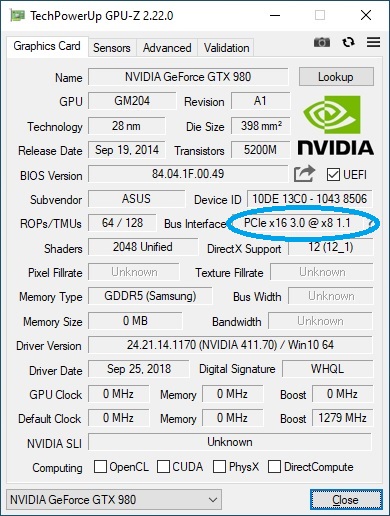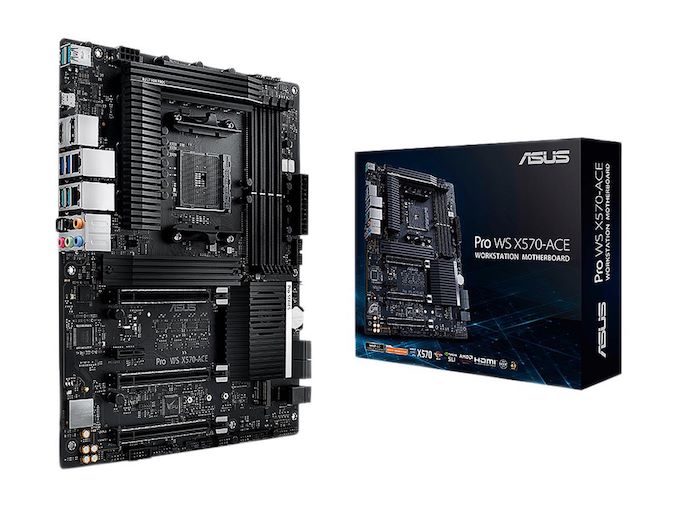The ASUS Pro WS X570-Ace Review: x8x8x8 with No RGB
by Gavin Bonshor on August 12, 2019 9:00 AM ESTASUS Pro WS X570-Ace Conclusion
Looking throughout the entire X570 product stack, there's a small handful out of 35+ models that aren't targetting gamers, but the only one to target the workstation users is the ASUS Pro WS X570-Ace. This sets it apart from the rest of the product stack and it's not just in the WS branding, but in its core feature set too. Firstly, it's the only X570 model to have three full-length PCIe 4.0 slots that run at a minimum of x8: x16, x8/x8, and x8/x8/x8. This is useful for users looking to run three NVIDIA graphics cards for various tasks such as gaming, rendering and virtual machines. Another important workstation related feature comes with the Realtek RTL8117 Gigabit NIC which allows users to hook it up with the ASUS Control Center Express application for virtual machine deployment, dedicated remote access through the Ethernet port, and even affords users the ability to install operating systems with PME, and PXE support. This is supplemented by an additional Ethernet port which is controlled by an Intel I211-AT Gigabit NIC.
Another notable inclusion a Realtek ALC1200S HD audio codec which comes geared with an EMI shield and PCB separation for a much better experience, and the out of the box DPC Latency performance wasn't too bad either. The power delivery on the ASUS Pro WS X570-Ace consists of a 12+2 phase power delivery running in a 6+1 configuration with an ASP1405I PWM controller and 14 x IR3555 60 A power stages for the CPU teamed up in pairs, with 2 x IR3555 60 A power stages for the SoC section; also teamed up with aim on reducing transient response times in the phase switches for more efficiency, and ultimately better thermal performance. Touching more on the thermal performance in our new power delivery thermal analysis, the ASUS Pro WS X570-Ace out of the boards we have tested so far proved to be exceptional with a recorded temperature of 52°C measured from our thermal probe.
Touching on the overclocking performance and the WS X570-Ace once again proved its worth with consistent performance in our POV-Ray benchmark testing, and managed to push our testbed Ryzen 7 3700X processor to its limit of 4.3 GHz at 1.375 V. We did manage to get into Windows 10 with 4.4 GHz, but it required too much CPU VCore and as a result, was highly unstable and too warm for even our premium 240 mm AIO CPU cooler to handle. In terms of cooling, the ASUS Pro WS X570-Ace has six 4-pin fan headers with two for CPU fans, one for an AIO water pump, and four for chassis fans. Performance in our CPU and gaming test suite is competitive and the only caveats came in POST time which is down to the initializing of the Realtek RTL8117 Gigabit NIC during POST; once this is turned off, we managed to reduce the booting time into Windows 10 by around 13 seconds; not an issue for workstation users, but certainly doesn't look attractive to users that are impatient.
Looking at the rear panel, ASUS includes four USB 3.1 G2 Type-A and a single USB 3.1 Type-C port, with a further two USB 3.1 G1 Type-A ports. This is certainly ample for a board of this calibre and users looking to add more can add four USB 2.0 ports via two headers, and an additional two USB 3.1 G1 Type-A ports across two headers. For users looking to use Ryzen APUs, there are two video outputs including an HDMI 1.4b, and a DisplayPort 1.2 output. The Realtek ALC1200 HD audio codec is 8-channel and as a result, offers users with five 3.5 mm audio jacks and S/PDIF optical output; there's also a front panel audio connector located next to the audio PCB.

The bottom full-length PCIe 4.0 slot on the ASUS Pro WS X570-Ace operates at x8
It would be unfair to compare the ASUS Pro WS X570-Ace motherboard to other models in the product stack due to its focus on workstation and professional use, but for $380, this model does offer everything needed to create a good looking system for gaming and workstation use and even without all the integrated RGB LEDs, this actually adds appeal to this model. The ASUS Pro WS X570-Ace ($380) is priced the same is its gaming-centric ROG X570 Crosshair VIII Hero Wi-Fi ($380) model, and is slightly more expensive than the MSI MEG X570 Ace ($370) which we previously reviewed at launch. Aside from the full-length PCIe 4.0 x8 slot triple-header and remote access capabilities, the Pro WS X570-Ace is also unique as it's the only X570 model with a PCIe 3.0 x4 U.2 port onboard, and the two PCIe 4.0 M.2 slots operate at x4/x2, which does cap the performance of the second M.2 slot a little; this is most likely a PCIe lane limitation of running a full-length PCIe 4.0 x8 slot from the chipset in comparison to the regular x4 on all other X570 models.
The ASUS Pro WS X570-Ace goes in a different direction for users looking to build a dedicated workstation, but with Ryzen's Pro CPUs coming in at a much lower cost than AMD's own TR4/SP3 platform overall, it gives an element of value for users to grasp while being able to spend the budget saved on other areas such as VGA and storage.
For casual users, there are other models which offer more consumer-friendly features for a better price. But overall the ASUS Pro WS X570-Ace is a good buy for users looking for a more professional feature set on the X570 chipset, for those interested in remote access and VMWare deployment, and triple full-length PCIe 4.0 x8 slot layout.
AnandTech Ryzen 3000 CPU and X570 Motherboard Coverage
- The AMD X570 Motherboard Overview: Over 35+ Motherboards Analyzed
- The MSI MEG X570 Ace Motherboard Review: Ace in the Hole at $369
- The AMD 3rd Gen Ryzen Deep Dive Review: 3700X and 3900X Raising The Bar
- AMD 16-Core Ryzen 9 3950X: Up to 4.7 GHz, 105W, Coming September
- AMD Zen 2 Microarchitecture Analysis: Ryzen 3000 and EPYC Rome
- AMD Ryzen 3000 Post-Review BIOS Update Recap: Larger ST Gains, Some Gains, Some Losses












110 Comments
View All Comments
shabby - Monday, August 12, 2019 - link
I agree, the difference between $200 and $400 boards is slim. The extra power/vrm features aren't needed since all cpus hit a 4.3ghz wall, 10gbe should be standard here.1_rick - Monday, August 12, 2019 - link
I bought one of these a couple days after launch and it came with a code for 20% off a custom cable order at CableMod.funks - Monday, August 12, 2019 - link
PCIE Bottlenecked out of the box.Target: Hypothetical 4K -> 8K Video Editing workstation station (using Davinci Resolve)..
Wants:
2 - x8 lanes PCIE 3.0 Video Cards - Primary and Secondary X16 slots
x4 lanes NVME PCIE 4.0 (OS / Application Drive) - Primary M2 slot
x4 lanes NVME PCIE 4.0 (Data / Scratch Drive) - Secondary M2 slot (hanging off chipset)
x4 lanes PCIE 2.0 (10 Gigabit NIC) - Tertiary x16 slot (hanging off chipset)
PCIE 4.0 NVME x4 drives already exist out in the wild, so if you plug one of those on the secondary M2 slot (Data Drive), and happen to plug in a 10 GB PCIE 2.0 x4 card on the third mechanical PCIEx16 slot - then you are bottle necking already as both are trying to go through the PCIE 4.0 x4 link between the chipset and the CPU. For 4K -> 8K Video Editing using a shared file server (connected via 10 Gigabit NIC) along with the DATA drive (secondary M2 running at PCIE 4.0 x4) as a scratch disk - there's a bottle neck. Davinci Resolve for example can use multiple video cards (so primary and secondary PCIEx16 slot will be at 8x each populated with a video card). Primary M2 slot can be used with PCIE 4.0 NVME for OS / Application Data.
It's like buying a network switch without adequate switching capability for the number of ports exposed. I guess it's why TR4 ain't obsolete.
cygnus1 - Monday, August 12, 2019 - link
I'd say it's fine. You're just building it wrong. I'd suggest putting the scratch disk on the x4 NVMe slot and your boot/app drive on the x2 slot. Scratch disk needs throughput a lot more than the app/boot disk. PCIe 4.0 x4 is overkill for a disk if it's just boot and apps, x2 is fine. The lesser number of channels does not reduce IOPs capabilities and that's more important than bandwidth on the boot/app disk.funks - Monday, August 12, 2019 - link
For the price you pay on these boards, shouldn't have to compromise.BTW, what's up with the dual LAN ports on these boards? People planning on setting up their machines as a router or something? Those two PCIE lanes (One for Realtek LAN - RTL8117 , and one for Intel LAN - I211-AT should have been connected to an Aquantia 10 Gigabit NIC instead.
2 - PCIE 3.0 lanes have about 2 GB/sec of bandwidth, plenty for a 10 Gigabit ethernet
cygnus1 - Monday, August 12, 2019 - link
So, realistically this has 1 real NIC. The RTL NIC is the remote management controller, aka a BMC. I myself really wouldn't put that on a network that gets exposed to the internetkobblestown - Monday, August 12, 2019 - link
I fail to see why would anyone choose this instead of a Threadripper board. I bought the Asrock X399 Professional Gaming (stupid name!) one year ago for 350 UK pounds and TR 1920X for the same price. The board has 10G ethernet + plus 2 1G intel ones (plus WiFi but who uses that for real work), 8 memory slots with ECC support, two 16x and 2 8x PCIe slots plus three M.2 slots. No compromises. It even has a serial port (so you can configure Linux with serial console support and log in over that from, say, an RPi). I don't miss anything I see here.ibejohn818 - Monday, August 12, 2019 - link
Really liked Asus x99 WS boards. However, this feels like a girl with a stuffed bra and fake id... you take her home and realize you can't go all-the-way :(.I hope they put together an x399 WS board for TR3 release and I'm looking forward to seeing the TR3 yields and if slim yields are going to raise the prices on the top of the line sku's
Lord of the Bored - Monday, August 12, 2019 - link
But without the lights, how will you know it is working?The_Assimilator - Tuesday, August 13, 2019 - link
What utter trash. No front USB 3.2, no 10GbE, only 7 rear USB ports. "Workstation" used to mean "no frills and tons of features", Asus has changed that to "has no RGB and costs double the price of better-featured boards".